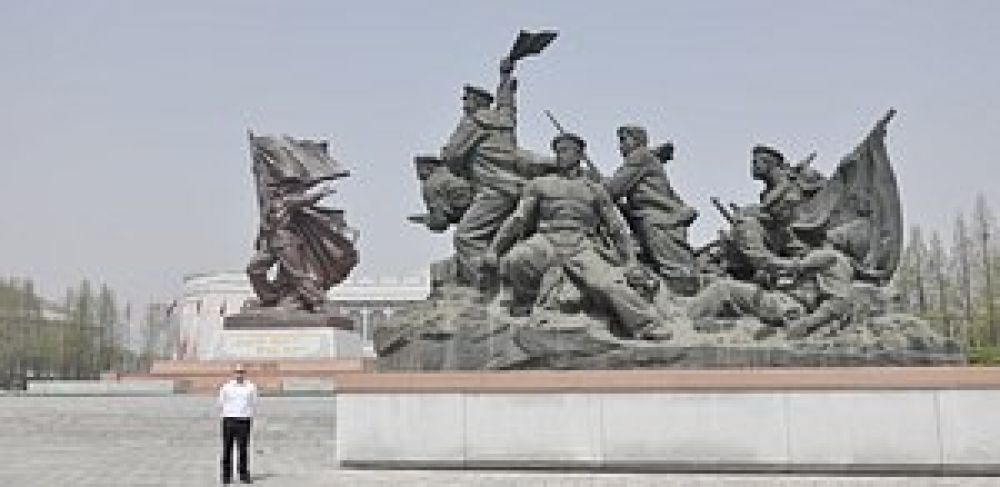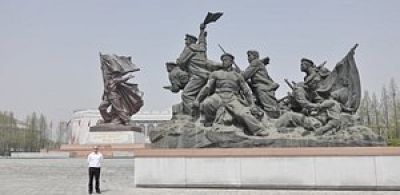

The Victorious Fatherland Liberation War Museum offers a comprehensive, state-led narrative of the Korean War, known in North Korea as the Fatherland Liberation War. Visitors can join a mandatory guided tour delivered by knowledgeable guides, often in military uniform, who will lead you through vast halls showcasing dioramas, war relicts, and relics from the conflict. One can expect to hear a version of history that is heavily slanted to glorify the North Korean struggle and its leaders. The exhibits include weaponry, photographs, and documents providing an immersive insight into what North Korea considers as its triumphant resistance against American aggression. Personal anecdotes and stories of valour and sacrifice abound, giving visitors a sense of the intense national pride ingrained into the narrative of the war.
A centerpiece attraction of the museum is a massive, 360-degree diorama that depicts the Battle of Daejon. With incredible attention to detail, the diorama places visitors in the midst of one of the key battles of the war, as seen from a North Korean perspective. The experience is made more vivid through lighting and sound effects, creating an atmosphere meant to evoke both awe and reverence for the North Korean military's wartime efforts. The diorama is a feat of artistry and propaganda, and the scale of the display is a testament to the lengths the government goes to commemorate its version of history. As the lights dim and the story unfolds, visitors are sure to get a sense of the immense emotional weight the Korean War still holds in North Korea.
One of the more striking exhibits at the Victorious Fatherland Liberation War Museum is the outdoor display of captured US military equipment. This section functions as a sort of war trophy collection meant to symbolize North Korean military prowess and the perceived humiliation of American forces. Among the hardware on show, visitors will find tanks, planes, artillery pieces, and even the USS Pueblo, an American naval vessel captured in 1968. Walking among these stark reminders of conflict, tourists are invited to contemplate the tangible reality of war. Each piece is accompanied by plaits offering details of their capture and supposed failures of the American military strategy. It is an opportunity for reflection and photography, albeit with a narrative that underscores the might and righteousness of the DPRK's armed forces.
The USS Pueblo is one of the museum's most unique draws. This United States Navy intelligence vessel was captured by North Korean forces in 1968, sparking an international incident. The ship is moored on the Potong River, adjacent to the museum, and serves as a floating exhibition space. Visitors can board the vessel and explore its various compartments and machinery, preserved much as they were at the time of capture. The guided tour will cover the history of the incident, the capture of the crew, and the subsequent negotiations for their release. On display are items such as the original crew's belongings, espionage equipment, and bullet holes from the attack on the ship, emphasizing the perceived triumph over American espionage efforts. This tour is a vivid lesson in both the history and the skillful use of propaganda by the North Korean regime.
While not directly part of the museum complex, a visit to the Revolutionary Martyrs' Cemetery is often paired with the museum tour due to its thematic connection to North Korea's wartime history. Located in the outskirts of Pyongyang, the cemetery is dedicated to the North Korean soldiers who died in the liberation struggle against Japan and the Korean War. Guides narrate the tales of heroism and sacrifice as visitors walk along neatly manicured paths lined with statues and graves. The visit sculpts a profound sense of national sacrifice, as embodied by the prominent busts of fallen soldiers, against a panoramic backdrop of the city. This somber and reflective experience is designed to allow visitors to pay their respects and deepen their understanding of the North Korean national narrative of struggle and victory.
Within the museum, there is a section devoted to the biographies of notable war heroes and revered leaders, especially the Eternal President Kim Il-sung, and his son, Kim Jong-il. The personal stories of soldiers and strategists who contributed significantly to the war effort are presented in great detail, with personal items, photographs, and descriptive texts. For the North Korean citizens, this is an educational experience; for foreign visitors, it offers insight into the cult of personality central to North Korean political culture. While the accounts are heavily embellished with ideological rhetoric, they provide context to the deep-rooted national pride and the militaristic ethos that permeate North Korean society.
Part of the museum experience includes a film screening that provides a North Korean perspective on the Korean War. These films are typically state-produced documentaries featuring archival footage, dramatic reenactments, and a narrative that underscores the heroism of North Korean fighters and the leadership qualities of the Kim family. Watching such films furnishes visitors with an appreciation for the power of state media in shaping historical perception. The screening is also an exercise in understanding the cinematic ways through which North Korea projects its ideology and legitimizes its rule, all woven into the telling of the country's most significant conflict in recent history.
An interesting and unique activity available for visitors is a lecture on the Juche philosophy - the official state ideology of North Korea that emphasizes self-reliance and independence, conceived by Kim Il-sung. The talk delves into how Juche influenced North Korea's approach to the war and its strategies. It elucidates how the ideology is intertwined with the nation's identity and military narratives. The lecture is an invaluable window into the ideological underpinnings of the North Korean regime and an opportunity to understand its pervasive impact on every aspect of North Korean life. It might be given by museum staff or by a designated political education officer, customarily providing an orthodox depiction of the nation's guiding principles.
The museum offers specialized educational tours for school groups, focusing on the indoctrination of young North Koreans into the state's version of history. These tours are led by museum educators trained to communicate the historical narratives along with the moral and political lessons deemed appropriate for school children. The educational tours often involve interactive sessions, pop quizzes, and storytelling that are designed to instill a sense of national identity and patriotic fervor. For international observers, attending or witnessing one of these tours can be a highly revealing experience concerning the methods of historical education in North Korea.
For history buffs and photography enthusiasts, the museum offers the chance to engage in a photography session while touring. Visitors are allowed to take pictures of most of the historical artifacts and memorabilia, subject to certain restrictions that the museum or the guides might impose. The collection includes a wide range of items from wartime communications equipment to personal belongings of soldiers. Photographs taken here can be quite poignant, capturing the emotion and gravity that the North Korean state associates with these objects. It's a way to preserve memories of the visit and gain deeper insights into the Korean War through the lens of North Korean curation.
